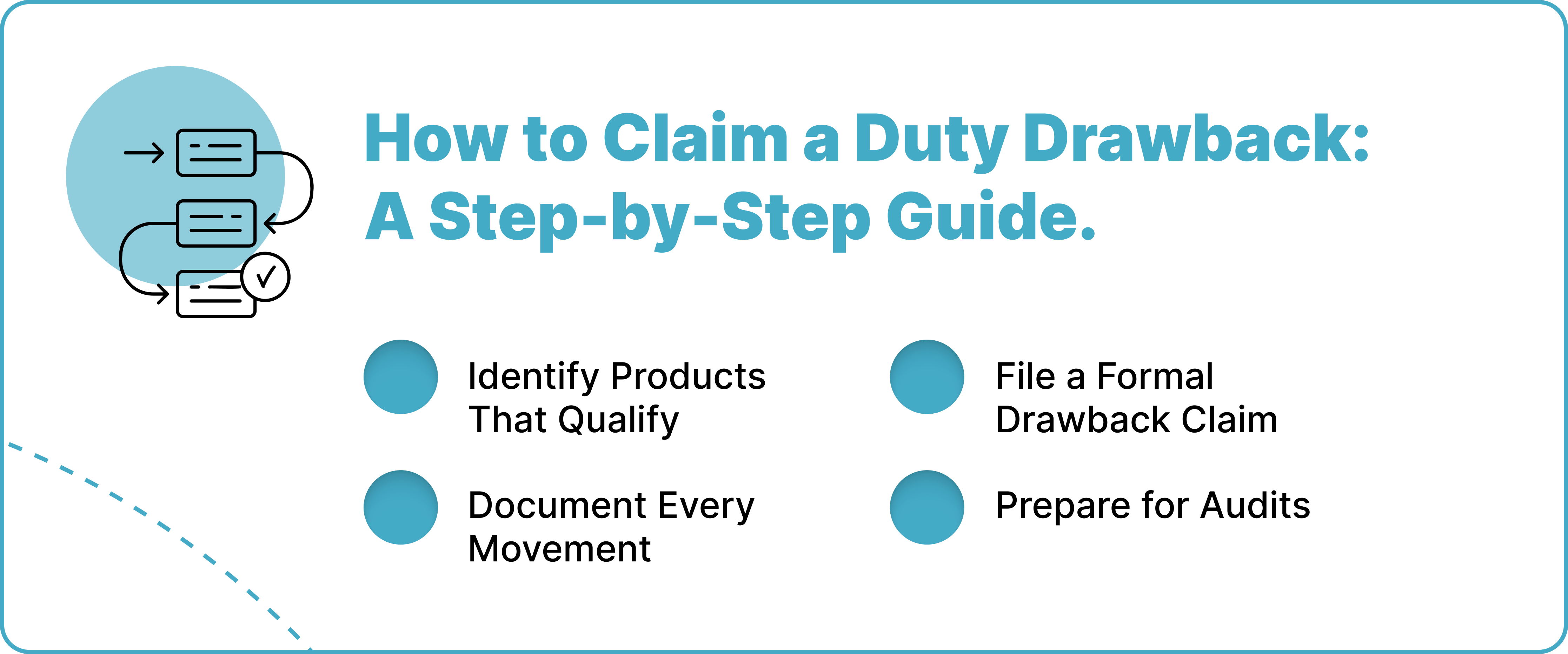Duty Drawback Guide: Recovering Lost Revenue on International Returns

Many global e-commerce businesses selling into the U.S. treat return losses as an unavoidable cost of doing business. That’s a costly mistake. Every international shipment into the U.S. is subject to import taxes, duties, and fees — expenses that add up quickly. But if those goods are later returned and re-exported, you may be eligible for a duty drawback: a refund of some or all of the duties previously paid. To take advantage of this opportunity, accurate documentation is essential. With the right process in place, you can recover significant lost revenue on international returns.
International returns are expensive. However, most of the damage doesn’t come from the cost of shipping items back. It’s from the money you never tried to recover. Many people ignore this; others are unaware of its existence. And the rest think it’s too hard to manage. But if you run international returns management correctly, this refund can become automatic and profitable. This is known as a duty drawback refund, which allows businesses to recover the duty paid on imported goods that are subsequently exported.
This article will explore how tax refunds on returns work and how to build a system that lets you recover lost revenue through proper import and export documentation instead of leaving it behind.
What Is Duty Drawback and Why Does It Matter?
A customs duty drawback is a refund of customs duties, taxes, and fees paid on goods imported into the U.S., including import duties and tariffs paid on imported merchandise, then later exported or destroyed. In the U.S., the Customs and Border Protection (CBP) office oversees this program. Their rules allow companies to recover up to 99% of certain duties and taxes if they can prove the goods left the country again.
Here is why it matters: When a buyer in the U.S. returns a product, and that item goes back across the border, whether to Canada, Mexico, or Asia, you’ve paid twice: first, to import it, then to ship it out again. This matters because your e-commerce business may lose money twice if you don’t file a duty drawback claim as stipulated in the Trade Enforcement Act.
Here is a typical example of the international return cost recovery in action: A cross-border fashion retailer imports 10,000 jackets into the U.S. as imported merchandise and pays $60,000 in import duties and tariffs paid on that imported merchandise. Then, unfortunately, customers return 1,000 jackets, which are shipped back to their warehouse in Singapore. Without a manufacturing drawback claim, the $6,000 in import duties and tariffs paid on those returned imported products stay with the government. With a proper system, that $6,000 is refunded.
Most Online Retailers and E-commerce Businesses Lose This Money. Here’s Why.
U.S. CBP data shows businesses lose over $2 billion annually in unclaimed duty drawback refunds. Most international sellers lose their refunds because they do not track returns with drawback claims in mind. Many businesses also fail to file drawback claims simply due to a lack of awareness or understanding of the process.
Every step of the inbound logistics and returns process must be documented to be eligible for these duty drawbacks. You may never recover the money without key documentation, like proof of export, ordinary customs duties paperwork, return reason codes, and timely claim submissions. Unfortunately, this results in a silent loss, and the numbers accumulate over time.
How to Claim a Duty Drawback: A Step-by-Step Guide

Although claiming duty drawback can appear cumbersome on paper, you just need a clear step by step process in your returns management operation and across the entire supply chain and shipping process.
Here’s how smart retailers get their customs duty reimbursement consistently: The processing and approval of duty drawback claims can take several months, and claims are only paid out once they have been fully processed.
1. Identify Products That Qualify
Although the duty drawback is available to all international shippers, not all returns qualify. To qualify for duty drawback and be eligible for export tax recovery, the returned goods must meet the following criteria:
- Be imported into the U.S.
- Be exported or destroyed.
- Not be significantly used or altered in the U.S.
- Be unused merchandise to qualify for certain types of drawback, such as unused merchandise drawback and rejected merchandise drawback, which are specific provisions for goods that are exported or destroyed without being used.
Using these criteria, only products that meet these requirements qualify for duty drawback. The exported product must not have been used or altered in the U.S. Digital goods, food, and custom-manufactured items often don’t qualify. However, categories where returns are frequent and predictable, like electronics or fashion, must be returned in the same condition to qualify.
2. Document Every Movement
Although the necessity for a duty drawback is more profound than ever, CBP requires proof. Without them, your claim drawback can be denied if they do not meet specifications. Additional documentation may include:
- Entry summary from import
- Export shipping documents
- Proof of return from the customer
- Inventory records matching serial numbers or SKUs
- Return reason (must be legitimate—not just disposal)
- For certain types of drawback claims, such as direct identification drawback or manufacturing substitution drawback, you may be required to use direct identification methods to trace imported materials or raw materials through the supply chain and demonstrate that the exported goods are the same as those originally imported or used in production.
These documents or proofs are also not difficult to get, and a complete list can simplify the process. For example, by leveraging the returns portal, an e-commerce business can capture the import ID, reason for returns, and automatically generate shipping labels, all of which serve as evidence of the product returns.
3. File a Formal Drawback Claim
Making claims for the duty drawback goes beyond just sending an email with evidence of the product return. The filing process for claims must be made through the appropriate channels and must ensure the following:
- Supported by all required documentation
- Submitted within 5 years of the date of import
- Filed with U.S. CBP using the correct drawback code
You may file through a customs broker, an attorney, or independently. Businesses also have the option to self-file their drawback claims using the electronic ACE system, as paper filing is no longer accepted. However, it is important to note that claims for duties paid typically take 3–12 months to process, depending on volume and accuracy. To receive refunds more quickly, businesses may apply for accelerated payment or accelerated payment privilege, which can expedite refunds — often within 90 days — if eligibility requirements are met.
4. Prepare for Audits
Drawback claims are subject to review. If your documents are incomplete or inconsistent, you may lose your refund, and future claims may be flagged. Keep a clean record, including manufacturing records and chain of custody, and store your records securely for at least five years. For certain types of drawback claims, such as destruction of goods, CBP supervision is required to ensure compliance and eligibility for refunds.
Best Practices to Maximize Your Refunds
Retailers who recover the most money treat import duty refunds as part of their core returns management strategy. The following best practices will help you reclaim duties on international returns reliably:
- Automate document collection at the return start point. When the customer initiates a return, capture the SKU, order ID, and return reason up front.
- Train fulfillment staff to link exports to original imports. Don’t let returns pile up without a clear match to original shipments.
- Use technology to sync returns and reverse logistics data. This prevents mismatches between inventory and customs filings.
- File monthly, not yearly. Frequent filings make auditing easier and improve cash flow.
Recent updates to the duty drawback program, including expanded eligibility under the Trade Facilitation and Trade Enforcement Act, are enabling businesses to recover more costs through streamlined customs procedures and broader criteria for duty drawback refunds. It is important to stay informed about changes in regulations and industry trends to maximize your potential refunds and ensure compliance.
Simplify The Duty Drawback Claims and Payment With ReverseLogix
Two things can be true here. Manually recording and claiming the duty drawback for returns is possible. It is also inefficient. However, with a returns management software like ReverseLogix, your entire team can automate duty drawback claims by tracking import entry summaries :
- Customs IDs
- Refund amounts
- Return shipment flows
- Import/export paperwork
- Claim submission deadlines
A system like ReverseLogix tracks the return from the buyer to export. It ensures all claims are properly processed and that imported materials are tracked from import through export, supporting compliance and accurate duty recovery. Our solution can assist your team by simplifying processes such as tagging shipments with the import number, logging them in the customs queue, and preparing duty drawback claims without manual input.
That means: less staff time, fewer lost refunds, and more cross-border returns efficiency. Our application also improves return forecasting, inventory sync, and customer communication. All from one dashboard. Get a demo.

Duty Drawback FAQs (Frequently Asked Questions)
You can recover up to 99% of duties and import taxes paid on goods that are later returned and exported. The exact amount depends on your country’s rules, the kind of product, and how well your documents match up. Merchandise drawback, duty refund, and drawback refund are all terms used to describe the process of recovering duties paid on imported merchandise.
Many countries offer some form of tax refunds on returns. These include:
United States (via CBP)
Canada (through CBSA)
European Union (via the Union Customs Code)
India (via the Duty Drawback Scheme)
Australia, Mexico, Brazil, and China, among others
Each has its own rules, claim forms, and timelines. If you sell to more than one country, consider using returns software or hiring local experts to keep things organized
To file a valid claim, you’ll usually need:
Proof of import (customs entry form, duty payment receipt)
Export documentation (commercial invoice, shipping label, export declaration)
Return data (RMA numbers, return dates, refund confirmation)
Product matching (serial numbers or SKU-level detail that links import to export)
Missing documents are the number onereason duty drawback claims are rejected. Automating this step reduces risk and speeds up the recovery of international return costs.
Note: For certain types of claims, such as manufacturing substitution drawback or direct identification drawback, additional documentation may be required to prove the use of raw materials or the identity of the exported prod
Not linking the return to its original import record is the biggest mistake retailers make. If your systems can’t prove the same item was both imported and later exported, your claim will fail if you cannot prove re-export.
Tip: Assign return tracking numbers that tie back to import batches or SKUs. This lets you build an audit trail. The best international returns management platforms handle this mapping for you in real time.
Failing to identify eligible duties or other eligible duties can result in missed refunds.
The deadline depends on the country:
U.S.: Up to 5 years from import date
Canada: 4 years from duty payment
EU countries: 3 years (varies slightly)
India: Within 1 year of export
The sooner you submit, the faster you recover funds. Claims submitted late or missing required data often get delayed or denied. Claims must be submitted within the required timeframe to claim duty drawback on imported merchandise.
